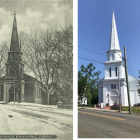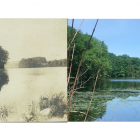Around Town
New Canaan Now & Then: ‘The Little Brown Church on the Hill’
|
Next door to the New Canaan Museum & Historical Society in the building that now houses St. Michael’s Lutheran Church was St. Mark’s Episcopal Church, photographed c. 1912. Even though it was built in 1834 and hails as the oldest church in New Canaan, this was not its original location. The first church was located about three-quarters of a mile northwest near the cemetery located at the bottom of West Road. Construction on this church began in 1764 and does not seem to have ever been finished. Perhaps due to its incompleteness, or that it was possibly never consecrated, the church was never given a name, but was referred to as the “Episcopal Society in Canaan Parish.” It was finished enough to allow services though, but services were only held sporadically. For nine months out of the year, parishioners had to travel eight or so miles to worship in Stamford or Norwalk.
Eventually in 1791, New Canaan parishioners voted to separate from the Stamford and Norwalk parishes and to form their own. In 1832, work began on the second Episcopal church located today at 5 Oenoke Ridge. The land was purchased by Captain Stephen Betts of the Continental Army and Edward Nash for $200 and construction finished in 1834. Research is inconclusive as to why it was named for St.




